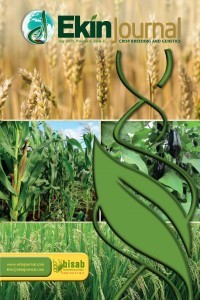Nutrient Use and Uptake Efficiency in Wheat and Triticale Genotypes under Low and Optimum Input Conditions
Nutrient Use and Uptake Efficiency in Wheat and Triticale Genotypes under Low and Optimum Input Conditions
N, P and Zn content, harvest index and grain yield were used to evaluate diverse 32 wheat and triticale genotypes
categorized in four groups i.e. Triticum aestivum, Triticum durum, synthetic wheat and triticale genotypes. The genotypes
differed significantly for all the characters indicating considerable variation for improvement of these traits. The varieties
LoK1 and HD2687 were having highest grain yield under low and optimum input conditions respectively, while HD 2687
showed maximum percent of increase over low input conditions. PBW343 and P7307 were having highest harvest index
under low and optimum input conditions respectively, whereas Syn5 was found to show highest percent of increase over
low input conditions. As nutrient use and uptake parameters are concerned, for N content triticale genotypes TL2963
and TL2967 showed highest content under low and optimum input conditions, while percent increase over low input
conditions was found to be highest in HD2687 (285.96 per cent). Genotypes TL2966 and Syn36 were having highest P
content under low and optimum input conditions respectively among all the four groups, while TL2969 responded better
over low input conditions. Among all the four groups triticale genotype TL2963 showed trend having high content of zinc
under both low and optimum input conditions, whether for percent of increase over low input conditions P7531 responded
better. Path coefficient analysis revealed that harvest index followed by biological yield had the direct effect under both
conditions.
Keywords:
Nutrient use efficiency, wheat and triticale, N, P Zn content in wheat,
___
- Anonymous (2010). Progress report of the All India Coordinated Wheat & Barley improvement Project 2009-10 - Crop Improvement. (Eds.) Shoran J, Tiwari, V, Chatrath, R, Verma, A, Singh, G, Tiwari R, Kumar R, Tyagi, BS, Sareen S, Singh SK and Singh SS Vol I, DWR, Karnal (Haryana), India. Azad BS, Gupta SC and Peer AC (1998). Influence of organic and inorganic fertilizers in maximizing wheat yield at irrigated conditions. Environment & Ecology. 16 (1): 71-73. Bieleski RL (1973). Phosphate pools, phosphate transport, and phosphate availability. Annual Review of Plant Physiology. 24: 225-252. Grahham PH and Vance CP (2000). Nitrogen fixation in perspective: an overview of research and extension needs. Fields Crop Research. 65: 93-106. Moll RH, Kamprath EJ, Jackson WA (1982). Analysis and interpretation of factors which contribute to efficiency of nitrogen utilization. Agronomy Journal. 74: 562-564. Ortiz Monasterio JI, Sayre KD and Rajaram S (1997). Genetic Progress in Wheat Yield and Nitrogen Use Efficiency under Four Nitrogen Rates. Crop Science. 37:898-904. Rengal Z and Graham RD (1995). Importance of seed Zn content for wheat growth on Zn-deficient soil. Plant and Soil. 173: 259-274. Singh VP and Prasad A (1998). Effect of nitrogen levels and weed control methods on wheat under rainfed and irrigated conditions of low roll and valley situation. Annals of Agriculture Research. 19 (1): 72-76. Tilman D, Fargone J, Wolff BD, Antonio C, Dobson A, Howarth R, Schinder D, Schlesinger WH, Simberloff D and Swackhamer D (2001). Forecasting agroculturally driven global environmental change. Science. 292: 281-284. Torabi M and Malakuti MJ (1997). Evaluation of sources and rates of nitrogen on rainfed wheat and determining its DRIS indices. Soil and water journal. 10 (1): 21-28
- ISSN: 2149-1275
- Yayın Aralığı: Yılda 2 Sayı
- Başlangıç: 2015
- Yayıncı: Bitki Islahçıları Alt Birliği
Sayıdaki Diğer Makaleler
Genetic Analysis of some Important Quantitative Traits in Bread Wheat (Triticum aestivum L.)
Effects of Drought on Morphological Traits of some Sunflower Lines
Yalçın KAYA, Veli PEKCAN, Nuran CICEK
Genome-Wide Association Mapping Using a Bayesian Mixture Model for Plant Height in Oryza sativa
